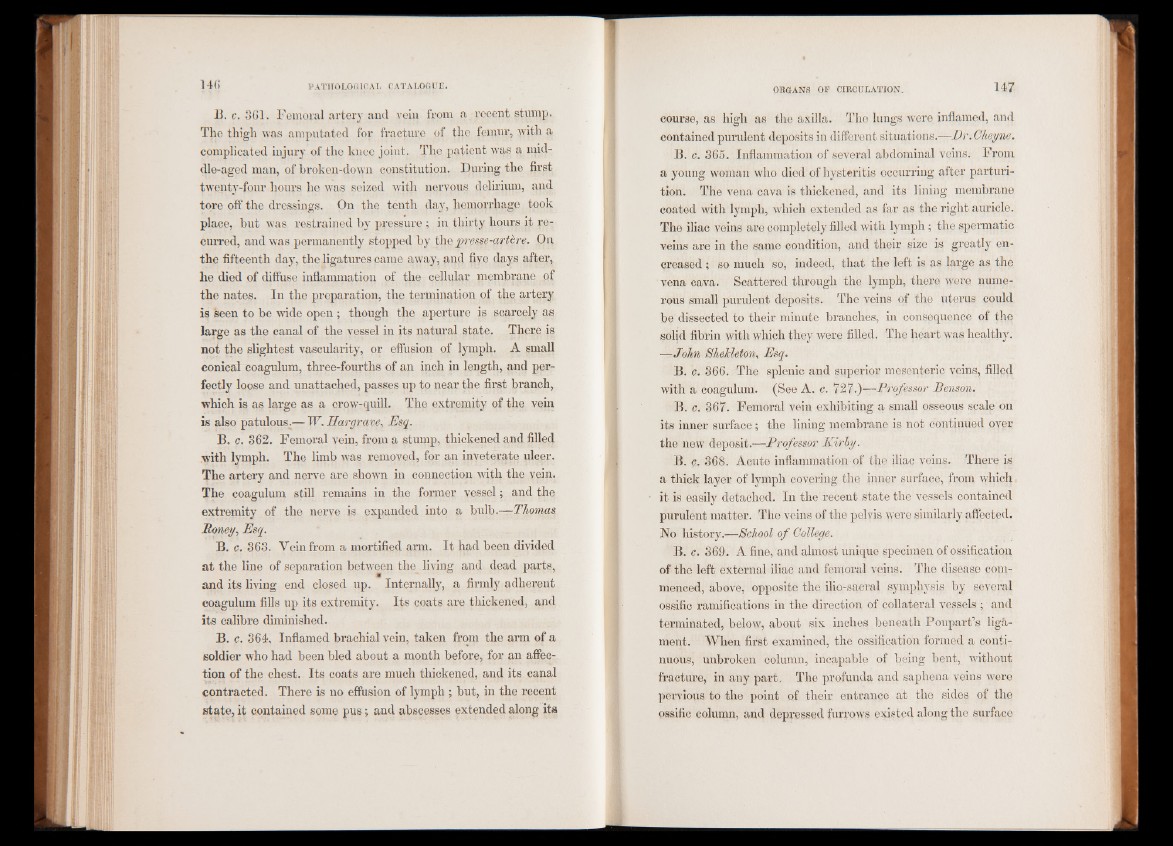
B. c. SGI. Femoral artery and vein from a recent stump.
The thigh was amputated for fracture of the femur, with a
complicated injury of the knee joint. The patient was a middle
aged man, of broken-down constitution. During the first
twenty-four hours he was seized with nervous delirium, and
tore off the dressings. On the tenth day, hemorrhage took
place, but was restrained by pressure ; in thirty hours it recurred,
and was permanently stopped by the presse-artère. On
the fifteenth day, the ligatures came away, and five days after,
he died of diffuse inflammation of the cellular membrane of
the nates. In the preparation, the termination of the artery
is seen to be wide open ; though the aperture is scarcely as
large as the canal of the vessel in its natural state. There is
not the slightest vascularity, or effusion of lymph. A small
conical coagulum, three-fourths of an inch in length, and perfectly
loose and unattached, passes up to near the first branch,
which is as large as a crow-quill. The extremity of the vein
is also patulous..— W. Hargrave, Esq.
B. c. 362. Femoral vein, from a stump, thickened and filled
with lymph. The limb was removed, for an inveterate ulcer.
The artery and nerve are shown in connection with the vein.
The coagulum still remains in the former vessel ; and the
extremity of the nerve is expanded into a bulb.—Thomas
Honey, Esq.
B. c. 363. Vein from a mortified arm. It had been divided
at the line of separation between the living and dead parts,
and its living end closed up. Internally, a firmly adherent
coagulum fills up its extremity. Its coats are thickened, and
its calibre diminished.
B. c. 364. Inflamed brachial vein, taken from the arm of a
soldier who had been bled about a month before, for an affection
of the chest. Its coats are much thickened, and its canal
contracted. There is no effusion of lymph ; but, in the recent
state, it contained some pus ; and abscesses extended along its
course, as high as the axilla. The lungs were inflamed, and
contained purulent deposits in different situations.—Dr.Cheyne.
B. o. 365. Inflammation of several abdominal veins. From
a young woman who died of hysteritis occurring after parturition.
The vena cava is thickened, and its lining membrane
coated with lymph, which extended as far as the right auricle.
The iliac veins are completely filled with lymph ; the spermatic
veins are in the same condition, and their size is greatly en-
creased ; so much so, indeed, that the left is as large as the
vena cava. Scattered through the lymph, there were numerous
small purulent deposits. The veins of the uterus could
be dissected to their minute branches, in consequence of the
solid fibrin with which they were filled. The heart was healthy.
—John SheJcleton, Esq.
B. c. 366. The splenic and superior mesenteric veins, filled
with a coagulum. (See A. c. 727.)—Professor Benson.
B. c. 367. Femoral vein exhibiting a small osseous scale on
its inner surface; the lining membrane is not continued over
the new deposit.—Professor Kirby.
B. c. 368. Acute inflammation of the iliac veins. There is
a thick layer of lymph covering the inner surface, from which
it is easily detached. In the recent state the vessels contained
purulent matter. The veins of the pelvis were similarly affected.
No history.—School of College.
B. c. 369. A fine, and almost unique specimen of ossification
of the left external iliac and femoral veins. The disease commenced,
above, opposite the ilio-sacral symphysis by several
ossific ramifications in the direction of collateral vessels ; and
terminated, below, about six inches beneath Poupart’s ligament.
When first examined, the ossification formed a continuous,
unbroken column, incapable of being bent, without
fracture, in any part. The profunda and saphena veins were
pervious to the point of their entrance at the sides of the
ossific column, and depressed furrows existed along the surface